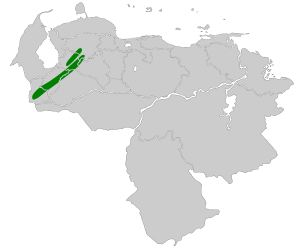Mérida tapaculo facts for kids
Quick facts for kids Mérida tapaculo |
|
|---|---|
| Conservation status | |
| Scientific classification | |
| Genus: |
Scytalopus
|
| Species: |
meridanus
|
 |
|
The Mérida tapaculo (Scytalopus meridanus) is a small, secretive bird. It belongs to a family of birds called Rhinocryptidae, known as tapaculos. This special bird is found only in Venezuela.
Contents
About the Mérida Tapaculo
For a long time, the Mérida tapaculo was thought to be a type of brown-rumped tapaculo. But scientists noticed that its songs and calls were very different. Because of these unique sounds, they decided it was its own separate species.
There are two main types, or subspecies, of the Mérida tapaculo. One is called S. meridanus meridanus. The other is S. m. fuscicauda, also known as the "Lara" subspecies. Scientists are still studying if the "Lara" subspecies is truly different or just a variation.
What Does it Look Like?
The Mérida tapaculo is a small bird, about 10.5 to 11.5 centimeters (4 to 4.5 inches) long. It weighs about 13.5 to 16.5 grams (0.48 to 0.58 ounces).
Male birds have a dark gray upper body with some brown. Their rump and wings are brown. Their throat, chest, and belly are a lighter gray. The sides of their body and the area around their tail are a reddish-brown with faint darker stripes.
Female birds are generally paler than males. However, the brown on their upper body is darker. Their reddish-brown sides are also brighter. Young birds are mostly brown. They are darker on top and lighter underneath, with striped underparts.
Where Does it Live?
The Mérida tapaculo lives only in the Andes mountains of Venezuela. The S. meridanus meridanus subspecies lives further south. You can find it in Mérida and Táchira States.
The "Lara" subspecies lives north of that area. It is found in Lara and Trujillo States. These birds like to live in the thick plants and edges of wet mountain forests. They can be found among Chusquea bamboo, but it's not their favorite spot.
The S. meridanus meridanus subspecies usually lives at high elevations. This is from about 2,200 to 4,000 meters (7,200 to 13,100 feet) above sea level. The "Lara" subspecies lives a bit lower. It is found from about 1,600 to 3,200 meters (5,200 to 10,500 feet) high.
Behavior
What Does it Eat?
Scientists don't know much about what the Mérida tapaculo eats. They also haven't studied how it finds its food.
Reproduction and Nests
Not much is known about how the Mérida tapaculo reproduces. However, two nests of the "Lara" subspecies have been found. These nests were shaped like globes. They were made from moss, small roots, and leaves.
The nests were hidden in cracks in a rock wall. One nest had one egg, and the other had two eggs. Both parent birds helped to keep the eggs warm. Sadly, the eggs in both nests were eaten by predators before they could hatch.
Its Unique Song and Calls
The Mérida tapaculo has a special song. It starts with a few notes that go lower. Then, it turns into a rising trill, which is a fast, vibrating sound [1].
It also makes several different calls. You can hear examples of its calls here: [2], [3], and [4].
Is it in Danger?
The IUCN (International Union for Conservation of Nature) has looked at the Mérida tapaculo. They have assessed it as being of "Least Concern." This means it is not currently considered to be in danger of disappearing.
Even though its home range is somewhat small, and we don't know the exact number of birds, it seems to be common. Its population also appears to be stable. Both subspecies of the Mérida tapaculo live in several protected areas.
See also
 In Spanish: Churrín de Mérida para niños
In Spanish: Churrín de Mérida para niños


